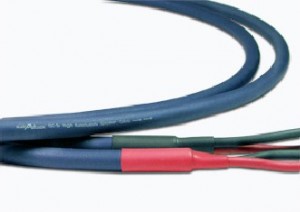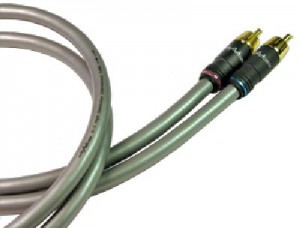A while ago I did a review of the Audio Art IC-3 and IC-5 interconnects, affordable cables that have gained a reputation for great sound and stellar value. I really believe in a system approach regarding cabling, so I asked for a review sample of the loudspeaker cable that Rick Fritz has to offer. After some initial struggles to “re-connect” with Rick, finally we were able to get together.
The following constitutes my impressions of the loudspeaker cables physical construction and the sound when used with the Audio Art interconnects. The IC-3s were used between my old Pioneer CD-54 cd player and my preamp, while the 5’s were relegated between my preamp and power amp. Of interest here is that I used the McCormack Microline Drive in passive mode, and my old QED PCC passive control centre (sporting good quality Alps blue poteniometer, QED internal wiring and good quality RCA connectors. The selection switches are a positive contact type). Amplifiers used were my 41Hz Amp6 Basic and the McCormack DNA .5 deLuxe. My previous use cabling is the old school Audioquest Ruby interconnects throughout, and Audioquest Indigo speaker cable. I detected no observable issues regarding using the 1 metre pair ICs with either of my passive preamps.
A lot of ink has been spilt over the years in both the specialist and “mainstream” audio press regarding cabling, “AB testing”, objectivity vs. subjectivity, blah, blah, blah…Thus “listening to cables” is quite an odd thing to do. After all, they are supposed to be completely neutral (which I propose they are not) in both sound and electrical parameters. Of course they can’t be, considering that all conductors and dielectrics have physical properties. How are we to know completely what the sounds were that were captured during any recording session? We can only guess. All cabling acts as some kind of filter. Those we enjoy with particular equipment often have “sympathetic” properties that somehow make listening more enjoyable, or more analytical, or, or, or…whatever it is that an individual holds as a listening priority.
Concerning cabling, the objectionists seem to be the most virulent in their arguments. Previously on these pages I have stated that I am a cable “believer”. I agree with both the objectionists and subjectionists, but ultimately let my ears decide. You should too.
Case in point, are the family of products from Audio Art. I really have enjoyed my time with the Audio Art interconnects. But I believe in a systems approach concerning cabling, and wanted to try the speaker cables. The Audio Art speaker cable looks very similar to the old Audioquest—similar sized and similar in exterior colour, a nice dark blue. The spade connectors are of superior quality (well at least they are larger and more robust) than the Audioquest ones—but in all fairness, the Audioquest’s were not factory terminated. I don’t think any will have problems with the spades on the Audio Art ones. Monster Monster spades dwarf either in terms of size and robustness. But the Audio Art ones are stepped to fit both large and small binding posts. I think a well thought out solution.
The results? Neither the amplifiers nor the loudspeakers used for this test had any problem grabbing hold of these cables. I will say that I have always kind of hated the binding posts on my little Castle Durham 900 loudspeakers. They never have seemed to grab spades in a way I feel completely comfortable with, and they loosen off fairly quickly as well. Not with these cables.
I recently changed the amp/preamp in my system back to my McCormack pair, as I had been listening to the 41Hz Amp6 Basic and my QED PCC passive preamp.for 4 months or so. What with efficient large full rangers (the Hemp Acoustics FR8.0c’s on an open baffle), small boxed fullrangers (the equally excellent but different planet10 hifi Fonkens), and even my less efficent Castle Durham 900s, the little pair produced music every day, with almost everything I threw at them. Well the McCormack never fails to feel like home, it’s big, and robust, and does have a certain delicacy to its presentation. Obviously not as delicate as the little pair, but certainly doesn’t sound like a PA type system either.
Well what happened? The McCormack pair’s sweet spot grew! More people could listen and enjoy music in my 12′ X19′ living room. Voices were pushed behind my rear wall. A layering of voices became more apparent. The acoustic “space” opened up and grew larger. The leading edges of instrument and voice had more attack, seeming more correct. This is starting to sound more like a full range driver listening experience, and to some degree, many of the effects that I heard while listening to the little T-amp and full rangers were there. Bass extension grew, as did treble. But it did not become irritating while listening.
The one thing that I cannot express in meaningful terms to anybody is what I call “sense of ease”. Systems that I have listened to and mentally marked as one of my all-time favourites have it. Perhaps in 20 years or so, I have heard three or four that I consider truly memorable, and none have been “nose-bleed” expensive. All have been analogue front-ended though. I have listened to many fairly expensive ($20k+ USD systems). Some at friend’s places (yup, I actually have a few), and some in retail stores (some as much as $150k USD). Well, with the Audio Art cables in my system, there is exactly that same sense of ease. Me thinks I’ll have to smooth some cables past the missus.
A final thought: All of the AudioArt cables are so well priced, that by the time you factor in good quality termination, DIY type cables aren’t even a consideration. The hassle in terminating wire on your own really isn’t worth it given the reasonable prices that Rick at Audio Art charges for his products.
external link: Audio Art IC-3
external link: Audio Art SC-5
Current pricing is
- IC-1 : $64.95 (USD)
- IC-3 : $115.00 (USD)
- SC-5: $160 (USD)
- SC-5 Bi-wire: $225 (USD)


